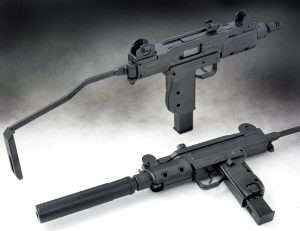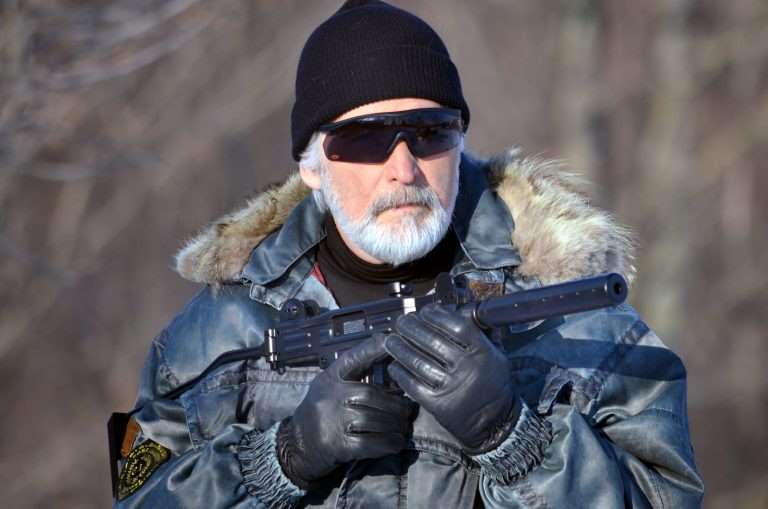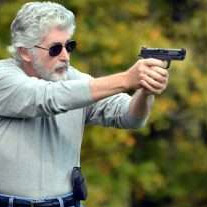The other Uzi option

I sometimes get so caught up with authenticity I overlook some otherwise very good airguns that are also based on original designs, like the Umarex Mini Uzi Carbine, which is a Mini Uzi pistol with a folding metal shoulder stock, i.e., pistol becomes carbine by swinging the forward folding stock around from against the receiver to your shoulder. In the real world of firearms, a Mini Uzi with folding metal stock is a fairly pricey item to own, but as a CO2 model, only about $100.

This one has been around for awhile and I have not really given it much coverage because I have always favored the select-fire version Mini Uzi Subgun (which you often see on the crawl at the top of the Pyramyd AIR home page showing popular or new models). The Umarex version is a semi-auto only model and it houses the CO2 in the grip and not in the removable BB magazine, while the select-fire Mini Uzi subgun uses self-contained CO2 BB magazines and costs about $30 more. But, there is absolutely nothing wrong with the Umarex semi-auto because it has the same style forward folding metal shoulder stock, plus it comes with a faux suppressor, which makes the gun a real conversation piece, and in the real firearms world a solid Title II firearm. But there are no requirements here, just a desire for a famous Israeli design that has become legendary.

An Uzi is an Uzi? Not so.
It is one of those rare firearms that has an unforgettable look, and since it has been around for over half a century most everyone has seen an Uzi in photographs of Navy SEALS, Federal Agents, and in use by good guys and bad guys alike in decades worth of movies and television dramas; most famously, perhaps, in the hands of Lee Marvin and Chuck Norris in the original 1986 Delta Force movie (unless you’re old enough to remember The Wild Geese starring Richard Burton and Roger Moore made in 1978).
Uzi is not an acronym for the gun; it is actually the name of the gun’s designer, Uziel Gal, a Captain with the Israel Defense Force (IDF) in the 1950s. Gal based his design on the Czechoslovakian Model ZK 476 and Czech Model M23/25 sub machineguns, but designed his version so it could be more efficiently manufactured for quick deployment to the new Israeli military. The final version was patented in 1952, with production rights assigned to the Israeli Ministry of Defense, which chose the designer’s nickname, Uzi, for the gun. In 1954, the Uzi was adopted by the Israeli military, and its fame spread from there. In 1975, Lt. Col. Uziel Gal retired from the Israeli military and spent the rest of his life in the United States working as a firearms designer. His designs included the Ruger MP9 sub machinegun. Gal passed away in 2002 at the age of 78.

The original Uzi SMG and its variants, Uzi Carbine, Mini Uzi, Micro Uzi and semi-auto Uzi Pistol, have remained a staple of military and law enforcement agencies the world over for more than 50 years and in calibers ranging from the original 9mm to .41 AE, .40 S&W, .45 ACP and .22 LR. Uzi .22 caliber rimfire conversion kits were first offered in 1987 and Umarex, (yes that Umarex) began offering .22 LR pistol and carbine models in 2012). The Uzi remained the Israeli military’s primary SMG for almost 50 years, finally being phased out by the IDF in 2003.
The details of making an Uzi CO2 model
Although Uzi construction is simple, a lot of forethought went into the gun’s engineering. Intended to lower manufacturing costs and make the Uzi easier to manufacture, the receiver is stamped out of flat steel and then formed around dies. The series of long ridges, also stamped into the sides of the receiver, is not for looks, but to strengthen the receiver flats against impact and damage. Unlike conventional rifles or sub machineguns the Uzi’s magazine inserts into the pistol grip just like a semiautomatic handgun, creating a better center of balance for one-handed operation. This also makes an Uzi faster to reload since the magazine well is already your hand. Another distinctive feature is the Uzi’s benchmark folding metal stock designs. First introduced in the 1960s, the collapsing design found on the larger carbines is regarded by many military arms historians as one of the best designs ever. Combined with the gun’s central pistol grip magazine well, the Uzi can be made as compact as possible for carry and ease of use when fired off hand or from the waist, yet, by simply pulling, or swinging, depending upon the model design, the shoulder stock into position, the gun can be rapidly converted into a shoulder-fired carbine. All of these fundamental features are reproduced in the Umarex Mini Uzi .177 caliber CO2 model.

Blowback Actions
The 9mm Uzi uses a blowback mechanism with a bolt that wraps around (shrouds) the back of the barrel, and the Umarex Uzi .22 models (remember, Umarex also makes the .22 LR versions, so they know how to build an Uzi), use a closed bolt blowback operated semi-auto action. The blowback action for the .177 caliber Umarex Uzi CO2 model operates almost the same. The air pistol also has an identical 9mm-style manual grip safety, charging handle, trigger design, and pistol grip safety. The latter much like a Colt Model 1911; in order for the firearm to discharge the grip safety must be fully depressed.
The Umarex Mini Uzi CO2 model is as close in measurements and fundamental operation as possible to an original c.1980’s 9mm Mini Uzi. The correct-style, reciprocating charging handle is mounted on the top of the receiver, and the ejection port on the right side of the receiver opens as if an empty shell case were being extracted, thus the Mini Uzi .177 has the authentic look and feel of the 9mm when fired, less, of course, for the recoil and report of a 9mm. It also bears the IWI Mini Uzi and factory stampings on the left rear of the receiver, a rear sight with two flip-up apertures, and authentic looking plastic grips and forend.

Exactly like the semi-auto 9mm models, a functioning Safe and Fire selector switch is at the top of the grips with the magazine release at the bottom center of the grip. From any angle, the CO2 model is a carbon copy of the centerfire and rimfire versions. The big difference is that a CO2 cartridge is loaded into the pistol grip by removing the right panel. After inserting the CO2, the integral seating screw in the base is turned clockwise until the cartridge is pierced. Replace the grip panel and you’re ready to go.

For external accuracy, the magazine has a full width base where is extends from the grip, but inside it uses a narrow stick magazine that holds 28 BBs. Among other special features that come with the Umarex Mini Uzi is the aforementioned threaded faux suppressor. While lighter than an original (since the receiver shell is polymer and not metal), the Mini still weighs in at 40 ounces empty. The gun has a 5.6 inch smoothbore barrel and an overall length (with faux suppressor and open shoulder stock) of 29.5 inches (14.1 inches w/o suppressor and stock folded). The pistol looks and feels right, and more importantly, it shoots great from the moment you pull the cocking handle to the rear, until the 28-round magazine is emptied out. Extra magazines cost $12.95, making them among the most affordable.
Shots downrange
Trigger pull averaged 6 pounds, 10 ounces on the test gun, and there’s 0.938 inches of take up with no appreciable resistance. It is a long, smooth trigger pull. The CO2-powered reciprocating action in the Uzi gives the airgun a little felt recoil; the gun’s report is medium-loud, and the combination gives this one a pretty nice feel when you pull the trigger.

Sighting through the rear aperture and tall front post sight puts the Mini Uzi right on POA at 21 feet, and at that range I was able to put 20 shots into an area measuring 1.75 inches (five high over the bullseye and 10), with 15 rounds very close in the 10 and X, and at least a best five in a ragged hole measuring 0.43 inches; the benefits of saturation shooting. But this is a very easy airgun to shoot accurately because of its weight and stability. It is quick to handle and fast to reload, just the way Uziel Gal intended.

The Uzi licensed Umarex, even as a semi-auto only version, (like centerfire and .22 LR caliber Title I Uzi models), remains a signature design anointed by firearms historians as legendary, in any caliber.
A word about safety
Blowback action airguns provide the look, feel and operation of their cartridge-firing counterparts and this is one reason why they have become so popular. Airguns in general all look like guns, blowback action models more so, and it is important to remember that the vast majority of people can’t tell an airgun from a cartridge gun. Never brandish an airgun in public. Always, and I can never stress this enough, always treat an airgun as you would a cartridge gun. The same manual of operation and safety should always apply.


Wow, yes I am old enough to remember “Wild Geese” with Richard Burton and Roger Moore…a great movie and ahead of its time for an action movie…Undoubtably the Uzi is a Firearm Legend.
I am 57 yo and I ‘ve seen the movie as I ‘ve seen the attempt on President Reagan. I wish there was a UNF adapter to the select fire co2 version. Quietness is elementary in our days and cities…
Bill